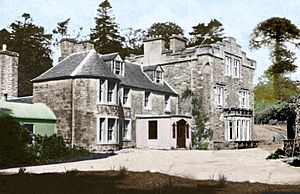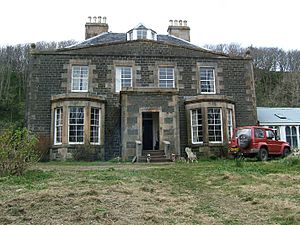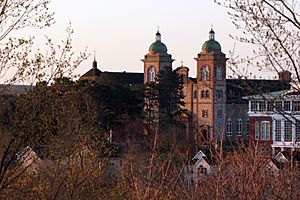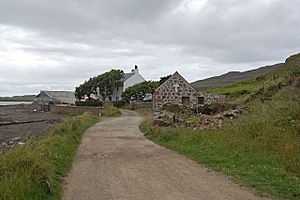John Lorne Campbell facts for kids
Dr John Lorne Campbell FRSE LLD OBE (Scottish Gaelic: Iain Latharna Caimbeul) (1 October 1906 – 25 April 1996) was a Scottish historian, farmer, environmentalist and folklorist, and recognized scholar of both Celtic studies and Scottish Gaelic literature.
Contents
Early life
According to his biographer, Ray Perman, the family of John Lorne Campbell claimed descent from the Clan Campbell tacksmen of Craignish (Scottish Gaelic: Mac Dúbhghaill Creaginnis, Clan Tearlach), through a son of disinherited 16th-century heir Tearlach Mòr. According to Penman, however, there is no documentary proof that the son of Tearlach Mòr ever existed.
The family is known, however, to have risen from modest beginnings due to the successful career "in trade" and in the British Army of General Sir Archibald Campbell, by whom the family estate at Inverneill was originally purchased, during both the Seven Years' War and the American War of Independence. Despite his own descent from the General's younger brother Duncan, John Lorne Campbell always referred to Sir Archibald in later years as his "honoured ancestor" and kept a portrait of him hanging inside Canna House. Sir Archibald's silver teapot was similarly kept permanently displayed on the mantlepiece of Canna House, next to the teapot of the General's wartime enemy, Vermont Patriot Colonel Ethan Allen, which Campbell's wife, American ethnomusicologist Margaret Fay Shaw, had inherited from her own family.
Campbell was born in an Edinburgh nursing home on 1 October 1906, but taken almost immediately to Inverneill House on the west shore of Loch Fyne, Argyll, Scotland. His father was Lieutenant Colonel Duncan Campbell, 8th of Inverneill (1880-1954) (called "Young Inverneill", to differentiate him from his father, who shared the same first name and military rank). His mother was Ethel Harriet Waterbury, a wealthy and cultured American heiress, from Morristown, New Jersey, whom Lt.-Col. Campbell had married in 1905 to bolster the estate's "flagging finances."
In contrast to his family's tenants, who were mainly Gaelic-speaking Roman Catholics and Presbyterians who attended religious services in nearby Tayvallich, Campbell was raised in the Scottish Episcopal Church and given a staunchly Pro-British, Pro-Empire, and Pro-Unionist upbringing within the Anglo-Scottish gentry of Argyllshire. Campbell later recalled that his family, like the other landowners of Argyll, felt a deep sympathy for the Anglo-Irish landlords and accordingly watched with horror the events of the Land War, the Easter Rising of 1916, and the Irish War of Independence.
He was educated at Cargilfield School in Edinburgh and then Rugby in England.
As he was expected to inherit the family estate, Campbell's coming of age in 1927 was celebrated with a feast and formal dance inside the massive stone barn at Taynish House. Campbell's Aunt Olive was in charge of organizing the party and invited not only friends and relatives, but also the estate tenants, most of whom her nephew had never met before. The tenants had secretly taken up a collection and gave Campbell a gold pocket watch and a pair of cufflinks. In return, Campbell recited a few words of Gaelic that he had learned for the occasion, "Tha mi gle thoilichte a bhith comhla ribha nochd." ("I am very pleased to be with you tonight.") Campbell was deeply touched by the warm response these words received.
Scottish nationalist
Beginning in 1926, Campbell's interest in learning his learning his heritage language was piqued during a visit to the Highland Games in Oban, where he overheard a conversation in Gaelic between four men from the Hebrides. Campbell later recalled, "I had never heard Gaelic spoken like that and I said to myself, 'That's something I should have!'"
Later that year, Campbell began attending St John's College, Oxford, studying Rural Economy with a minor in Celtic studies. The study of Rural Economy was intended to help Campbell learn how to profitably manage his future inheritance, but in 1928, Campbell learned to his horror and devastation that the Inverneill estate was being sold. Even though this was the only way to cover his father's considerable debts, both the Argyllshire gentry and Campbell himself would always view the sale as proof that his father lacked confidence in his ability to successfully manage the estate. Campbell would always treasure the gold watch and cuff links given by the Inverneill tenants at his coming of age party as a reminder of what might have been.
Campbell graduated in 1929 and receiving an MA in 1933. During this time, Prof John Fraser engendered a strong love of the Scottish Gaelic language and Scottish folklore. In the Oxford Gaelic Society, which Campbell also belonged to during the 1920s and early '30s, the 17th-century Classical Gaelic literary language was taught by reading the Irish bardic poetry collection Foras Feasa ar Éirinn by Fr. Geoffrey Keating, while the Scottish Gaelic vernacular was taught using the prose collection Caraid nan Gàidheal by Rev. Dr. Norman MacLeod.
In 1933, Campbell published the groundbreaking book Highland Songs of the Forty-Five, consisting of 32 Gaelic song-poems that he had tracked down with Prof. Fraser's assistance in both the Bodleian Library and the British Museum. These were analyzed for political content and published with facing translations into English blank verse. At the time, the real cultural, political, and religious reasons for the Jacobite rising of 1745 had been obscured by the novels of Sir Walter Scott and Robert Louis Stevenson, who both depicted, "the Highlander as a romantic hero fighting for a lost cause." In response, Campbell set out to give, "a voice to the voiceless - ordinary men who had never been allowed to speak for themselves".
In the introduction, Campbell expressed very harsh criticism of what were then widely held stereotypes, such as that speakers of Celtic languages are overwhelmingly melancholy, ignorant, but noble savages, or that the Scottish Gàidhealtachd was completely isolated from the literature and culture of the outside world. In reality, Campbell explained, the Jacobite war poetry of Alasdair mac Mhaighstir Alasdair (Alexander MacDonald, 1st of Arisaig) shows a very clear understanding of the political and dynastic issues at stake and abounds with learned allusions to both Classical mythology and the Christian Bible. Even the contemporary poetry of Duncan Ban MacIntyre, who was illiterate in his own language, is similarly filled with allusions to the Fenian Cycle of Celtic mythology, stories from which James Macpherson would later adapt into Ossian and use to capture the whole world's imagination.
In a very public rejection of his own ancestors' support for the House of Hanover and their role in the defeat of the Jacobite Army, Campbell also wrote, "the Rising of 1745 was the natural reaction of the Jacobite clans and their sympathisers in the Highlands against what had been, since the coming of William of Orange in 1690, a calculated genocidal campaign against the religion of many and the language of all Highlanders." Despite these deliberately provoking words, the book received favorable reviews.
In the mid-1930s, Campbell began living on the Hebridean island of Barra with the author Compton Mackenzie. On Barra, which Ray Penman has since described as, "a classless society", Campbell's childhood trauma over the lack of a caring father figure was eased by his close friendship with local seanchaidh John The Coddy MacPherson. During their conversations, whenever Campbell stumbled over his Gaelic phrases and retreated back into speaking English, MacPherson would hold up his hand and say, (Scottish Gaelic: "Abair siod fhathast, Iain.") ("Say that again, John.")
Also while on Barra, Campbell and Mackenzie founded the Sea League to fight for the rights of local fisherman. They also organised a successful tax strike by all Barra motor car owners as a protest against the Government's failure to properly maintain the island's roads. The tax strike led to many similar campaigns of civil disobedience and direct action, which gained wide publicity and forced the British civil service bureaucracy to make substantial changes that drastically improved the efficiency of both government and postal delivery in the Western Isles.
Personal life
On an extremely wet and rainy evening in 1934, Campbell was introduced as "Young Inverneill" to his future wife, American ethnomusicologist Margaret Fay Shaw, by the manager of the Lochboisdale Hotel on South Uist. Campbell later recalled, "As so often happens, we didn't take to each other at first, but we got to know each other and we were working in the same little world."
Their courtship was slow and awkward, but in March 1935, Margaret Fay Shaw brought Campbell to meet her family in Glenshaw, Pennsylvania. She later recalled that he spent the whole visit chasing butterflies in the nearby forest or typing up articles in his room. The whole Fay Shaw family accordingly decided that Campbell must not be seriously interested in Margaret and no one was more shocked than she was when Campbell proposed marriage on the last day of his visit.
In June 1935, John Lorne Campbell and Margaret Fay Shaw were married by Rev. Calum MacLeod in the manse of John Knox Presbyterian Church in Glasgow. Neither family attended and the bride was given away by family friend Fred Moir. At the groom's insistence, the entire ceremony was conducted in the Scottish Gaelic language and the bride was relieved to learn that she had only to say, "Tha" ("Yes"). The Campbells spent their brief honeymoon in the Lofoten and Vesteraalen Islands of Norway before returning to Scotland.
Folklorist, naturalist, and Laird of Canna
In addition to his other interests, in 1936 Campbell began to study the distribution and migration of insects. His Hebridean collection, started on Barra in 1936 was continued on Canna from 1938 with the use of a mercury vapour moth trap from 1951 onwards. The collection now consists of 30 cabinet drawers containing 283 species of macrolepidoptera, including the first recorded specimen of the noctuid moth Dianthoecia caesia taken in Scotland and some other surprises.
In June 1936, Campbell's work collecting and publishing Scottish Gaelic folktales tipped off the Irish Folklore Commission to the fact that the oral tradition still survived in the Gàidhealtachd. Dr. Séamus Ó Duilearga accordingly wrote to Campbell and invited him to visit the Commission's archives in Dublin. While Campbell was unable at the time to accept, their correspondence continued and was the beginning of a decades long collaboration.
In 1937, the Campbells' travelled to Nova Scotia with an Ediphone to record Canadian Gaelic folklore and traditional singers. The Campbells spent six weeks in Cape Breton, where they used the Ediphone to record upon wax cylinders ninety five Gaelic traditional songs and ballads, two games, seven local songs, and three original songs sung by their composer. John Campbell also persuaded Jonathon G. MacKinnon (1869–1944), the former editor of the literary magazine Mac-Talla, to introduce him to Gabriel Syllibuy, the Chief of Cape Breton's indigenous Mi'kmaq people. The Campbells recorded Syllibuy as he described, in the Mikmaq language, an account from the oral tradition about the arrival of the first Gaels in the Province. The Campbells also recorded other Mikmaqs singing Roman Catholic plain song hymns in the Mik'maq language.
The Canadian Gaelic song recordings made in Nova Scotia by the Campbells were later transcribed into musical notation with the assistance of Irish traditional musician and collector Séamus Ennis and published in the volume, Songs Remembered in Exile: Traditional Gaelic Songs from Nova Scotia Recorded in Cape Breton and Antigonish County in 1937, with an Account of the Causes of the Highland Emigration, 1790–1835.
During their visit, they also called at St. Francis Xavier University, where they met and befriended Fr. Moses Coady, a priest of the Roman Catholic Diocese of Antigonish and the founder of the Antigonish Movement. Campbell was later to praise Fr. Coady's ideas and to suggest that similar activism be introduced to Scotland.
In 1938 the couple bought the island of Canna, south of Skye, and went to live there in Canna House. He farmed the island for 40 years and made it a sanctuary for wildlife, while researching local history and folklore and also attempting to improve the prosperity of the local population. At the same time the Campbells continued to record a disappearing Gaelic heritage and to write and publish extensively about Highland culture, Scottish Gaelic literature, and life. Campbell was also the official insect migration recorder for Canna from 1938, and was at times able to get the help of more than one head lighthouse keeper from Hyskeir.
Crossing the Tiber
In 1946, after healing from a nervous breakdown at Oxford with the assistance of a Roman Catholic therapist, John Lorne Campbell was received into the Roman Catholic Church inside St. Ninian's Cathedral in Antigonish, Nova Scotia. While writing a subsequent explanation for his conversion, Campbell cited his intense dislike for the role that Protestantism had played in the 17th and 18th-century Whig political party and that party's legacy in creating the modern centralized British state. Campbell also explained that his research into Highland culture and history had led to many close and lasting friendships with Catholic priests and laity. Lastly, Campbell expressed an "aesthetic preference" for the Tridentine Mass over the High Church Anglican worship of his childhood.
In later years, Campbell would often deliberately irk visitors with anti-Catholic or Unionist views by speaking proudly of, "we Papists", expressing his admiration for the Jacobite risings, and his belief in Scottish nationalism. His wife Margaret followed him a few years later into the Catholic Church in Scotland, but always insisted that her favorite English-language Presbyterian hymns from her childhood be sung during Low Mass at St Columba's R.C. Church upon Canna, much to the incomprehension of the island's Gaelic-speaking population.
After John Lorne Campbell was received into the Catholic Church, his previous fascination with the iconic Gaelic poet Fr. Allan MacDonald ripened into an obsession. According to his biographer Ray Penman, "Over 20 years John was to devote a considerable amount of time and money to tracing the work of Fr. Allan, publishing much of it for the first time, righting wrongs he believed had been done to the priest and writing a short biography. The more he learned of him and read his work, the more he identified with him."
With the help of various friends and the universities of Glasgow and Edinburgh, Campbell succeeded in tracking down the poetry manuscripts, diaries, and detailed folklore notebooks of Fr. Allan MacDonald, which had been missing and presumed lost since his death in 1905. As word spread, others shared surviving letters to and from Fr Allan. Further detailed research by Campbell about Fr. MacDonald's life, times, and writings, as well as his diary, was similarly collected and housed at Canna, in the Inner Hebrides of Scotland. Campbell has been widely credited since with restoring both Fr. MacDonald's reputation and his enormous importance to Scottish Gaelic literature.
Campbell also continued to be involved in researching and publicizing the life and work of war poet Alasdair mac Mhaighstir Alasdair, who fought as a Captain in the Clanranald regiment of the Jacobite Army while also serving as a Gaelic tutor to Prince Charles Edward Stuart, and who is widely considered the greatest poet in Scottish Gaelic literature, with only Sorley MacLean as a recent exception. Campbell admired Captain Alasdair MacDonald very deeply, but was a very harsh critic of how systematically The Clanranald Bard's poetry had been bowdlerized for more than 200 years by puritanical editors.
Later life
In 1946, the Irish Folklore Commission dispatched trained folklorist Calum Maclean from Inverin in the Connemara Gaeltacht to the Hebrides with orders to begin systematic folklore collecting, with Campbell's assistance, that he later continued for the School of Scottish Studies.
During the early 1950s, American ethnomusicologist Alan Lomax used several of Campbell's field recordings without permission for a vinyl album of Scottish traditional music for Columbia Records, much to Campbell's chagrin.
In 1961, Campbell published Stories from South Uist, which he had begun collecting with a wire recorder from seanchaidh Angus MacLellan. Campbell explained that he had modeled his Gaelic-English translation of MacLellan's stories upon the recently published volume Tales from the Arab Tribes by Charles Grimshaw Campbell, which Campbell praised as, "a masterpiece of translation of folk-tales from another language into readable English." Angus MacLellan's similarly dictated autobiography, The Furrow Behind Me, was published in the same year.
The first collection of Fr. Allan MacDonald's Gaelic verse, Bàrdachd Mghr Ailein: The Gaelic Poems of Fr Allan McDonald of Eriskay (1859–1905), was both edited and self published by Campbell in 1965. In 1966, future Gaelic literary scholar Ronald Black received a suitcase full of Gaelic books from Campbell and brought them to Eriskay for sale aboard a ferry from Ludag, South Uist. At the time, Eriskay still had many Scottish Gaelic monoglot speakers who had known Fr. Allan MacDonald personally and Black has since recalled that the poetry book and Campbell's "little blue biography of Father Allan", both accordingly, "sold like hotcakes".
For much of the 1970s, Campbell fought a bitter but ultimately successful battle to maintain ferry service to Canna, which both he and the local population saw as a desperately needed lifeline to the outside world. Campbell later explained, "It was from my Campbell grandfather that I learned that it was the duty of a Highland laird to defend his tenants and employees - as Highlanders we did not consider a cash nexus the sole basis of our personal relationships with them. That was the basis of my own relationship with the Canna people. I can see that nowadays it is considered to be an old fashioned one, but I am prepared to stand by it at all times. If the laird wants loyalty from his tenants and employees, he must be loyal to them."
In 1981 Campbell donated Canna to the National Trust for Scotland, but continued to live on the island. Interviews with Campbell and Shaw were broadcast in 1985 on Scottish Television, in a programme called "Canna – an Island Story".
In 1990, Campbell was awarded an OBE by Queen Elizabeth II, but declined to travel to travel to Holyrood Palace for the ceremony. His biographer, Ray Perman, suspects that, "The thought of bowing before a Hanoverian monarch may have been too much for him." Instead, Ian Campbell, 12th Duke of Argyll, Chief of Clan Campbell, and Lord Lieutenant of Argyll and Bute travelled to Canna to present the award, but Campbell remained painfully shy had to be coaxed with difficulty into attending the ceremony.
According to Ray Perman, "In 1992, he received a Papal Knighthood. This accolade pleased him most, since it was granted on the recommendation of the Catholic priests of the islands and West Highlands -- men he respected and had worked with over decades. A Traditionalist in religious matters who always favored the Latin Mass, he nevertheless petitioned the Church authorities to have the service of investiture in Gaelic."
He died on 25 April 1996 whilst on holiday at Villa San Girolamo in Fiesole in Italy, and in accordance with his wishes was "buried where he fell". In 2006, however, Cambell's body was repatriated and reburied in a birch wood planted by himself near St. Columba's Roman Catholic chapel on Canna. In 2008, a headstone was taken from the garden at Taynish House on the Inverneill estate, brought to Canna, and set in a small cairn, with the inscription:
- Iain Latharna Caimbeul
- 1. 10. 1906 - 25. 4. 1996
- Fear Chanaidh
His widow remained living at Canna House until her death in 2004 at the age of 101.
Legacy
Campbell's partnership with Shaw was professional as well as marital. Together the couple assembled an important archive of both Scottish and Canadian Gaelic folklore, folksongs and poetry, including manuscripts, sound recordings, photographs and film, in an effort inspired by that carried on by Marjory Kennedy-Fraser in the 1900s. The Campbells' three-volume collection of Hebridean folk songs, published between 1969 and 1981, is regarded as a valuable source. The Campbells' archive at Canna House, which is a similarly invaluable source for scholars of Scottish Gaelic literature, Scottish traditional musicians, and folklorists, is now in the possession of the National Trust for Scotland. As of 2013, the many Ediphone wax cylinders, upon which the Campbells' had recorded folklore and traditional music in Scottish Gaelic, Canadian Gaelic, and Mikmaq, were on long term loan to the British Library for the purposes of being digitized. The School of Scottish Studies has since made the digitized recordings available online through the Tobar an Dualchais – Kist o Riches website.
Both the recent rise of Scottish nationalism and the ongoing efforts by the Scottish Parliament to ensure a Scottish Gaelic language revival through the setting up of immersion schools are also John Lorne Campbell's legacy.
A biography of Campbell, The Man Who Gave Away His Island by Ray Perman, was published by Birlinn Limited in 2010.
See also
- Margaret Fay Shaw
- Carter-Campbell of Possil







